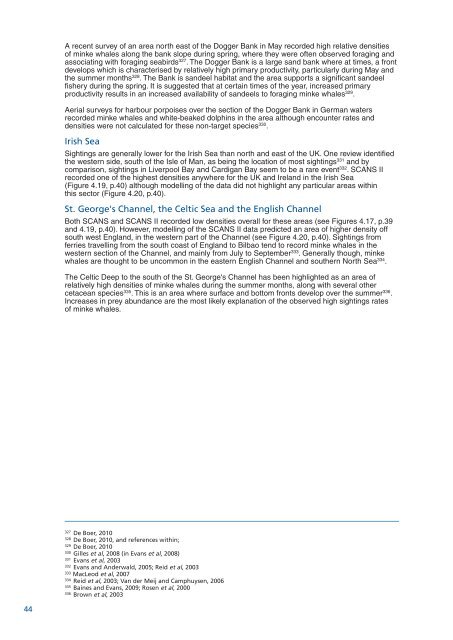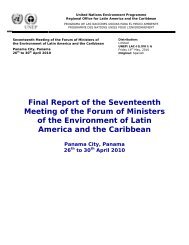A recent survey of an area north east of the Dogger Bank in May recorded high relative densitiesof minke whales along the bank slope during spring, where they were often observed foraging andassociating with foraging seabirds 327 . The Dogger Bank is a large sand bank where at times, a frontdevelops which is characterised by relatively high primary productivity, particularly during May andthe summer months 328 . The Bank is sandeel habitat and the area supports a significant sandeelfishery during the spring. It is suggested that at certain times of the year, increased primaryproductivity results in an increased availability of sandeels to foraging minke whales 329 .Aerial surveys for harbour porpoises over the section of the Dogger Bank in German watersrecorded minke whales and white-beaked dolphins in the area although encounter rates anddensities were not calculated for these non-target species 330 .Irish SeaSightings are generally lower for the Irish Sea than north and east of the UK. One review identifiedthe western side, south of the Isle of Man, as being the location of most sightings 331 and bycomparison, sightings in Liverpool Bay and Cardigan Bay seem to be a rare event 332 . SCANS IIrecorded one of the highest densities anywhere for the UK and Ireland in the Irish Sea(Figure 4.19, p.40) although modelling of the data did not highlight any particular areas withinthis sector (Figure 4.20, p.40).St. George's Channel, the Celtic Sea and the <strong>English</strong> ChannelBoth SCANS and SCANS II recorded low densities overall for these areas (see Figures 4.17, p.39and 4.19, p.40). However, modelling of the SCANS II data predicted an area of higher density offsouth west England, in the western part of the Channel (see Figure 4.20, p.40). Sightings fromferries travelling from the south coast of England to Bilbao tend to record minke whales in thewestern section of the Channel, and mainly from July to September 333 . Generally though, minkewhales are thought to be uncommon in the eastern <strong>English</strong> Channel and southern North Sea 334 .The Celtic Deep to the south of the St. George's Channel has been highlighted as an area ofrelatively high densities of minke whales during the summer months, along with several othercetacean species 335 . This is an area where surface and bottom fronts develop over the summer 336 .Increases in prey abundance are the most likely explanation of the observed high sightings ratesof minke whales.327De Boer, 2010328De Boer, 2010, and references within;329De Boer, 2010330Gilles et al, 2008 (in Evans et al, 2008)331Evans et al, 2003332Evans and Anderwald, 2005; Reid et al, 2003333MacLeod et al, 2007334Reid et al, 2003; Van der Meij and Camphuysen, 2006335Baines and Evans, 2009; Rosen et al, 2000336Brown et al, 200344
4.4.5 WHITEBEAKED DOLPHIN (Lagenorhynchus albirostris)White-beaked dolphins are found over a large part of the northern European continental shelf,favouring colder northern shelf waters, less than 200m deep 337 . In north west Europe, their distributionis centred around Scotland and north east England, where they can be seen throughout the yearbut with peaks between June and October 338 . UK waters may hold a significant proportion of thetotal population of white-beaked dolphins in the north east Atlantic 339 . High concentrations ofwhite-beaked dolphins are particularly noted for the west coast of Scotland, in the northern Minchand northern Outer Hebrides, and the western sector of the Sea of the Hebrides, and to the east ofthe UK in the northern and central North Sea 340 .Analysis of the distribution of sightings has led to the suggestion that white-beaked dolphins observedaround Scotland and north east England make up a local population, isolated to some extentfrom animals in shelf regions further north or west in the North Atlantic 341 . Movement betweenthese areas may be restricted by their preference for shelf waters, and by the deep oceanic watersthat separate these areas 342 .SCANS generated a population estimate for the survey area of 7,856 (CV 0.30; 95% CI = 4,032-13,301) white-beaked dolphins (see Figure 4.22, below). An estimate of 11,760 (CV 0.26; 95%CI = 5,867-18,528) was produced for Atlantic white-sided and white-beaked dolphins combined(see Figure 4.24, p.51), but the large majority of these are expected to be white-beaked dolphinsgiven that they greatly outnumber Atlantic white-sided dolphins in shelf waters where the surveytook place 343 . The highest densities of white-beaked dolphins were found in the western sectors ofthe northern North Sea, and the central North Sea. SCANS II took place ten years later and overan extended survey area which included the waters of western Scotland, omitted from the firstSCANS survey. This time, highest densities of white-beaked dolphins were found for the Hebrides,followed by the northern North Sea 344 (Figure 4.23, below). The population estimate for the extendedarea was calculated to be 22,664 (CV 0.42) for white-beaked dolphins, and 37,981 (CV 0.36) forboth Lagenorhynchus species combined (see Figure 4.25, p.51). Comparing estimates for the areacommon to both surveys, they were not found to be statistically different between years.337Reid et al, 2003338Reid et al, 2003; Northridge et al, 1995339JNCC, 2007340Hammond et al, 1995; SCANS II, 2006; Reid et al, 2003; Northridge et al, 1995 and 1997; Evans et al, 2003;MacLeod, 2001; Pollock et al, 2000; Stone, 1997, 1998, 2003, 2006; Weir et al, 2007 and 2009; Camphuysen et al,1995; Canning et al, 2008; Gill et al, 1997; Boran et al, 1999341Northridge et al, 1995; Northridge et al, 1997342MacLeod et al, 2005343Hammond et al, 1995344SCANS II, 200645
- Page 1 and 2: WDCS, the Whale and Dolphin Conserv
- Page 3 and 4: Towards Marine ProtectedAreas for C
- Page 5 and 6: South west EnglandCeltic Deep - com
- Page 7 and 8: CONTENTSExecutive Summary 2Acknowle
- Page 9 and 10: 1. INTRODUCTIONWe enter an exciting
- Page 11 and 12: Note: This schematic map shows thev
- Page 13 and 14: 2. IDENTIFYING MARINE PROTECTED ARE
- Page 15 and 16: 3. CRITICAL HABITATInterest in the
- Page 17 and 18: Foraging, travel, socialising and p
- Page 19 and 20: 4. DATA AND SPECIES ACCOUNTSIn orde
- Page 21 and 22: Killer whale (Orcinus orca)Atlantic
- Page 23 and 24: 4.4 SPECIES ACCOUNTS4.4.1 HARBOUR P
- Page 25 and 26: Although there is some variation in
- Page 27 and 28: North ScotlandThe first SCANS surve
- Page 29 and 30: East EnglandThe seasonal pattern in
- Page 31 and 32: Irish SeaOutside of coastal Welsh w
- Page 33 and 34: 4.4.2 BOTTLENOSE DOLPHIN (Tursiops
- Page 35 and 36: This expansion in range means this
- Page 37 and 38: 4.4.3 SHORTBEAKED COMMON DOLPHIN (D
- Page 39 and 40: South west EnglandBased on observat
- Page 41 and 42: 4.4.4 COMMON MINKE WHALE (Balaenopt
- Page 43 and 44: Sightings for this area of the Oute
- Page 45: The JNCC Atlas of cetacean distribu
- Page 49 and 50: 4.4.6 RISSO'S DOLPHIN (Grampus gris
- Page 51 and 52: 4.4.7 KILLER WHALE OR ORCA (Orcinus
- Page 53 and 54: 4.4.8 ATLANTIC WHITESIDED DOLPHIN (
- Page 55 and 56: 4.4.9 LONGFINNED PILOT WHALE (Globi
- Page 57 and 58: 4.4.10 SPERM WHALE (Physeter macroc
- Page 59 and 60: 4.4.11 BEAKED WHALESNORTHERN BOTTLE
- Page 61 and 62: which looked at worldwide beaked wh
- Page 63 and 64: There is no current population esti
- Page 65 and 66: 4.5 SCOTTISH MPA GUIDELINES - STAGE
- Page 67 and 68: Northern bottlenose whale and Sower
- Page 69 and 70: Fisheries BycatchFisheries bycatch
- Page 71 and 72: 5.2 AN OVERVIEW OF REGIONAL THREATS
- Page 73 and 74: North ScotlandAs in the west, threa
- Page 75 and 76: 6. IDENTIFYING CRITICAL HABITAT IN
- Page 77 and 78: 6.1.1 HARBOUR PORPOISEWest and sout
- Page 79 and 80: Assessment: Critical HabitatHigh re
- Page 81 and 82: 11. Area: Off Land's End, Cornwall
- Page 83 and 84: Threats, status and relative import
- Page 85 and 86: East Scotland3. Area: North east Sc
- Page 87 and 88: Threats, status and relative import
- Page 89 and 90: 6.1.4 COMMON MINKE WHALEWest and so
- Page 91 and 92: 6.1.5 WHITEBEAKED DOLPHINWest and s
- Page 93 and 94: Coastal Wales2. Area: Bardsey Islan
- Page 95 and 96: 6.1.8 ATLANTIC WHITESIDED DOLPHINNo
- Page 97 and 98:
Other areasOne other area was asses
- Page 99 and 100:
6.1.11 BEAKED WHALESThe northern Ro
- Page 101 and 102:
7. PROTECTING CRITICAL HABITAT - RE
- Page 103 and 104:
considered in the area, each of whi
- Page 105 and 106:
7.4 EAST SCOTLANDWithin the east Sc
- Page 107 and 108:
7.5 SOUTH WEST ENGLANDWithin the so
- Page 109 and 110:
An SAC is already in place for bott
- Page 111 and 112:
7.9 SUMMARYFour areas of identified
- Page 113 and 114:
iv. Licensing processes for industr
- Page 115 and 116:
9. IDENTIFICATION AND PRIORITISATIO
- Page 117 and 118:
Recommendations on particular data
- Page 119 and 120:
Coastal Wales northern Pembrokeshir
- Page 121 and 122:
ANNEX II SPECIES ACCOUNTS SUMMARY
- Page 123 and 124:
HARBOUR PORPOISEEast ScotlandStudyH
- Page 125 and 126:
HARBOUR PORPOISESouth West EnglandS
- Page 127 and 128:
HARBOUR PORPOISECoastal WalesStudyT
- Page 129 and 130:
BOTTLENOSE DOLPHINStudyTemporalReso
- Page 131 and 132:
SHORTBEAKED COMMON DOLPHINStudyTemp
- Page 133 and 134:
SHORTBEAKED COMMON DOLPHINStudyTemp
- Page 135 and 136:
COMMON MINKE WHALEWest ScotlandStud
- Page 137 and 138:
WHITEBEAKED DOLPHINStudyTemporalRes
- Page 139 and 140:
KILLER WHALEStudyTemporalResolution
- Page 141 and 142:
ATLANTIC WHITESIDED DOLPHINStudyTem
- Page 143 and 144:
SPERM WHALEStudyTemporalResolutionS
- Page 145 and 146:
BALEEN WHALESStudyTemporalResolutio
- Page 147 and 148:
ANNEX III THREATS TO CETACEANS - RE
- Page 149 and 150:
Actual orPotential ThreatActivitySp
- Page 151:
North ScotlandSpecies of most relev
- Page 156 and 157:
East EnglandSpecies of most relevan
- Page 158 and 159:
South East EnglandSpecies of most r
- Page 160 and 161:
South West EnglandSpecies of most r
- Page 162 and 163:
Irish SeaSpecies of most relevance
- Page 164 and 165:
Actual orPotential ThreatActivitySp
- Page 166 and 167:
Bravington, M., Borchers, D. and No
- Page 168 and 169:
Evans, P.G.H. and Anderwald, P. 200
- Page 170 and 171:
ICES WGMME. 2006. Report of the Wor
- Page 172 and 173:
ECS/ASCOBANS/ACCOBAMS Workshop held
- Page 174 and 175:
marine protected areas effective to
- Page 176:
ISBN: 9781901386233
















